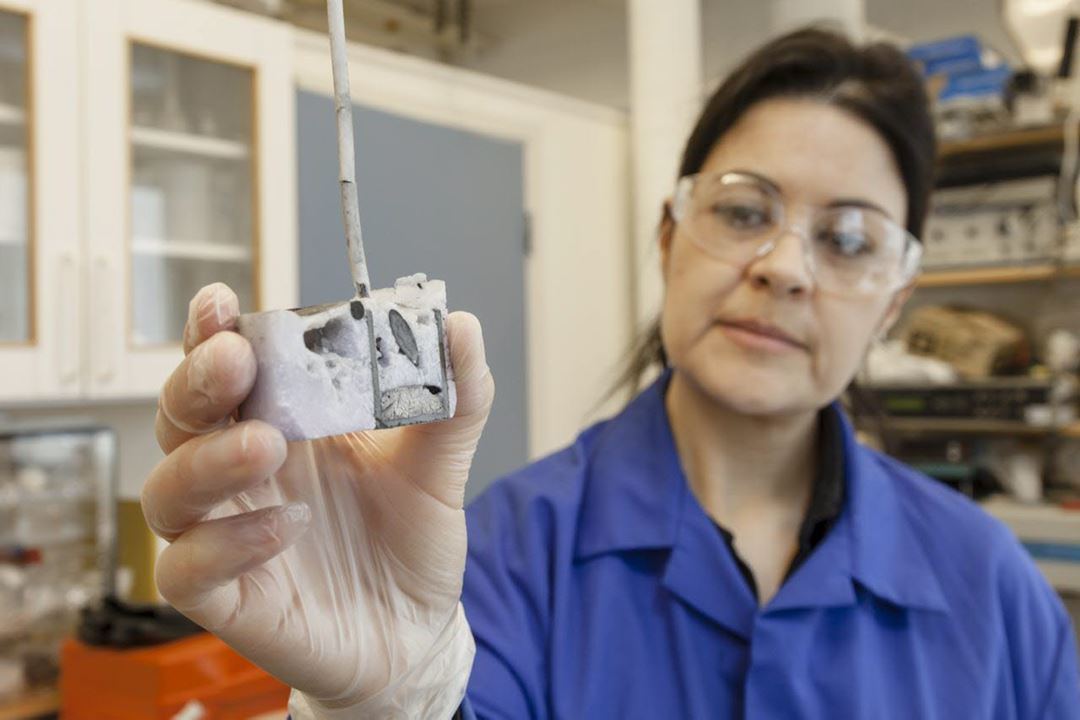Rare earth metals are essential materials for wind-turbines and environmentally friendly cars, but they are becoming scarcer by the day.
Norway, represented by SINTEF, is on the hunt for suitable methods of recovering them.
Scarcity expected by 2015
Rare-earth metals such as neodymium (Nd) and dysprosium (Dy) have been called the “key enablers” of green technologies.
They are vital ingredients in the electricity generators in wind-turbines, and in the electric motors that power electric and hybrid road vehicles.
However, the demand for these elements has risen much faster than their supply. Prognoses suggest that many of them will become scarce as early as 2015.
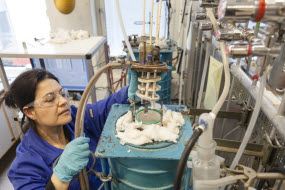
|
|
THE TECHNOLOGY: SINTEF’s Ana María Martínez prepares a metal recovery experiment. She is about to insert a sample-holder containing the magnet material into a test furnace for high-temperature electrolysis, where it will undergo a process similar to that used in aluminium smelting. All photos: SINTEF: Thor Nielsen |
Recovery is the first countermeasure
“It takes a good while to identify new commercially viable deposits and start up new mining operations. If we are to stop the development of wind-turbines and environmentally friendly cars from being slowed down, one important first step will be to recover these minerals from scrap materials. This is what we are trying to do something about,” says SINTEF scientist Ana María Martínez.
Supply under Chinese control
These rare earth metals are used not only in the energy and transport sectors, but also in a wide range of everyday products such as PCs, mobile telephones and LED lamps.
What many of these elements have in common is that they exist in large amounts in the Earth’s crust. However, they are seldom found in high enough concentrations to make extraction commercially viable, which is precisely why they are known as rare earth metals (REMs).
Until now, a single country – China – has supplied the whole world with these metals.
Chinese restrictions on supply
China is responsible for 95 percent of world production of REMs, in spite of the fact that the country sits on only about one third of global deposits.
During the past few years, however, China has begun to limit its exports of these materials.
“Urban mining”
This is why recovery of REMs from scrap is becoming a high-priority area of research in several countries. The European Union, for example, has already advertised major REM recycling research projects, and the topic is a central aspect of a project led by SINTEF, in which some of Europe’s largest research institutes are collaborating in the area of materials recycling.
This recycling strategy is known as “urban mining”. Two groups of materials scientists from SINTEF have joined the start of this race, financed to date by the Group’s own strategic funds.
The text continues below the pictures
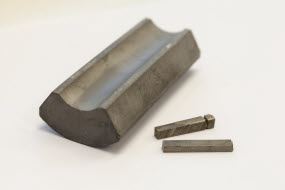
|
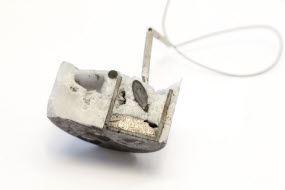
|
|
THE RAW MATERIAL: This is the magnet raw material that Martínez uses in her rare earth metal recovery experiments; it is what is known as a “master” alloy, produced for use in computer hard-disk units. The sample was donated by Professor T. Okabe of the University of Tokyo. |
THE RECOVERY PRODUCT: The content of an opened crucible after the alloy raw material has been subjected to electrolysis. Martínez hopes that the silver-grey material in the bottom of the crucible can become an alloy that can be used to make new magnets. |
Technology from metal production
As their point of departure, the SINTEF scientists have selected technology familiar from the aluminium and smelting industries.
Ana María Martínez, a Spanish researcher at SINTEF Materials and Chemistry, is a specialist in high-temperature electrolysis, a process best known in Norway from the aluminium industry.
In her hunt for potential materials for recovery of REMs, Martínez and a group of SINTEF colleagues have looked at permanent magnets, the most important range of products that contain REMs, in terms of both value and volume.
Much research still to be done
The most powerful magnets available on the market are made of alloys that contain the rare earths neodymium (Nd), praseodymium (Pr) and dysprosium (Dy) in addition to iron and boron, and these are what are used in wind turbines and electric vehicles.
Her preliminary studies have led Martínez to believe that a “twin” version of the electrolytic technology used in aluminium smelters could be used to recover magnetic alloys from discarded magnets and scrap materials from magnet manufacturers.
“The results of our recycling experiments using laboratory-scale electrolysis are promising. But the process is still too slow. A lot of research still needs to be done, because there are many aspects that need to be optimised before we can be certain of reaching our goals. But if we succeed, we will have a method that is much simpler than existing processes that are based on strong acids,” says Martínez.
Many challenges
There are also many problems to be solved in the steps that precede the electrolytic stage, points out the SINTEF scientist. For instance, the collection and dismantling of used magnets will have to be organised.
The magnets also have to be demagnetised at their point of origin, because long-distance transport of intact permanent magnets is not permitted.
According to Martínez, technology for demagnetisation at local level is currently being developed at the University of Birmingham in the UK.
“Permanent magnets tend to be exposed to high temperatures, so they are nickel-plated to protect them against corrosion. Some people claim that this coating will make recycling more difficult, but it will not be a problem for the process that we are considering,” says Martínez.
Will start with scrap
The SINTEF scientist thinks that the most sensible option will be to start the research project using scrap material obtained from magnet manufacturers. These materials are non-magnetic.
“It will be a while before there enough electric vehicles have been scrapped to make their motors into a significant source of REMs for recycling. However, there are probably already large volumes of magnetic alloys available in scrap from manufacturers. For some purposes, this is re-smelted in the production furnaces, but thee resulting alloys are left with properties that make them unsuitable for high-quality magnets,” says Martínez.
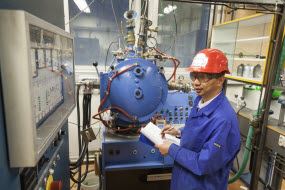
|
|
Metallurgy researcher Kai Tang of SINTEF Materials and Chemistry separates rare earth metal oxides from Ni-MH batteries using this high-frequency vacuum furnace. |
Focus on batteries too
Parallel to the efforts of Martínez, Kai Tang, a scientist with SINTEF’s Department of Metallurgy has started to look at the potential for recovering REMs from Ni-MH (Nickel metal hydride) batteries using high-temperature metallurgical methods.
Batteries of this sort are used in many hybrid vehicles, and they incorporate alloys that contain the rare earths cerium (Ce), lanthanum (La), neodymium (Nd) and praseodymium (Pr).
By adding slag, Tang has managed to remove many of the substances associated with the REM alloys he wishes to isolate.
“In Asia, several attempts have been made to recycle these alloys, but the processes involved are difficult to control,” he says.
Interdisciplinary cooperation
The Chinese scientist collaborates closely with his SINTEF colleague and electrolysis expert Ana María Martínez, in pursuit of his efforts to achieve the goals of the metallurgical recovery route.
The rare earth metals emerge from the metallurgical processes in the form of oxides, and electrolysis is one technique that turns oxides back into metals.
“Tang has shown that it is possible to significantly raise the concentration of REM alloys in his material. However, oxides of silicon and calcium remain in the product, and we are now trying to develop methods of eliminating these during electrolysis,” says Martínez.
Think recycling from the very beginning!
The Spanish scientist has a prayer for industry and the authorities:
“A great deal of money is being invested in developing new battery concepts. But we need to remember to put aside funding for research on recycling at the same time as new types of batteries are being designed!”
Text: Svein Tønseth
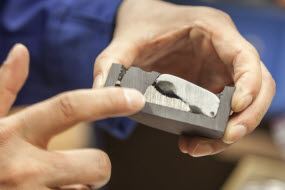
|
|
The components of the Ni-MH battery following treatment with high-temperature metallurgical processes at SINTEF. Separated, lowest centre; nickel-copper alloy. Top right; slag containing rare earth metal oxides. To the left is a graphite tube used as a thermo-element for temperature measurements during the experiments. |
